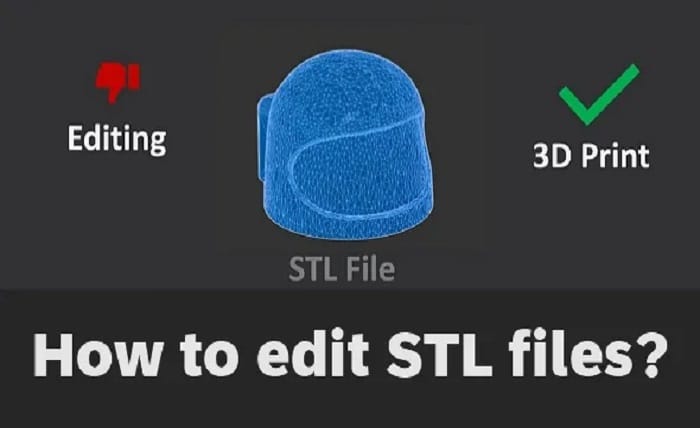Sculpt Your Digital Dreams: A Comprehensive Guide to Editing STL Files

The world of 3D printing has opened a realm of creative possibilities. But what if your perfect design needs a tweak, a twist, or a complete overhaul? That’s where the magic of editing STL files comes in. These unsung heroes, the building blocks of 3D models, hold the key to sculpting your digital dreams into tangible realities.
Dive in and discover the power to:
Fix imperfections: Say goodbye to wonky surfaces and misplaced polygons. Learn how to identify and rectify errors in your models for flawless prints.
Modify your creations: From scaling and rotating to adding intricate details, explore the vast canvas of possibilities for enhancing your existing models.
Merge and mash-up: Unleash your inner mad scientist! Combine elements from different files to create unique, never-before-seen designs.
Optimize for printing: Ensure your edits translate into smooth, efficient prints. Discover techniques for minimizing material waste and maximizing print quality.
Your Toolkit for STL Mastery:
To embark on your editing journey, you’ll need a trusty arsenal of tools:
3D Modeling Software: Blender, MeshMixer, Tinkercad, Fusion 360 – each tool offers unique strengths and learning curves. Choose the one that suits your skill level and project needs.
Mesh Editing Tools: Boolean operations, sculpting brushes, and vertex manipulation – these features form the core of your editing capabilities. Learn how to wield them with precision and finesse.
Now, let’s delve into the practical aspects of editing STL files:
Basic Fixes: Repairing holes, removing unwanted faces, and smoothing rough surfaces are essential skills for any aspiring editor. Master these techniques to ensure flawless outputs.
Adding and Combining: Expand your creative horizons by learning to add details, merge different models, and even create entirely new objects using existing meshes. Experimentation is key!
Advanced Techniques: For the truly ambitious, explore parametric modeling, retopology, and even animation editing to push the boundaries of your digital creations.
Remember, editing isn’t just about aesthetics; it’s about ensuring your edits translate into successful prints. Here’s how:
Manifold Meshes: Ensure your model doesn’t have leaks or overlapping surfaces, which can lead to printing errors. Tools like Meshmixer can help identify and fix these issues.
Minimizing Support Structures: By optimizing your model for minimal overhangs and sharp angles, you can reduce the need for support structures, saving time and filament.
Embrace the STL Editing Community:
The journey of editing STL files is filled with learning, experimentation, and sometimes…frustration. But fear not, for you’re not alone! Here are some valuable resources to support your endeavors:
Online Tutorials: Countless websites and YouTube channels offer in-depth tutorials on specific editing techniques, software functionalities, and troubleshooting tips.
3D Printing Forums: Join online communities of fellow enthusiasts where you can share your creations, ask questions, and learn from others’ experiences.
Paid Courses: If you’re looking for structured learning, consider enrolling in online courses focused on 3D modeling and STL editing.
Conclusion
Editing STL files isn’t just a technical skill; it’s an artistic endeavor. It’s about taking existing shapes and transforming them into your vision, breathing life into digital matter. So, embrace the challenge, explore the tools, and unleash your inner artist. Remember, every tweak, every modification, brings you closer to sculpting your digital masterpiece.
FAQ
Don’t worry! The world of STL editing welcomes beginners with open arms. Start with user-friendly software like Tinkercad or Meshmixer, and follow beginner-friendly tutorials to grasp the fundamentals. There are also plenty of online communities and forums where you can ask questions and receive guidance from experienced editors.
2. Is editing STL files difficult?
The difficulty level depends on the complexity of your edits and your chosen software. Basic fixes and modifications are relatively straightforward, while advanced techniques like retopology and animation editing require more practice and dedication. But remember, the learning curve is always rewarding, and the sense of accomplishment from mastering a new skill is unparalleled.
3. What can I edit in an STL file?
The possibilities are limitless! You can:
- Fix errors: Eliminate holes, smooth rough surfaces, and repair broken meshes.
- Modify existing models: Scale, rotate, adjust dimensions, and add or remove details.
- Combine models: Merge different STL files to create unique mash-ups and hybrid creations.
- Create new objects: Use existing meshes as building blocks to design entirely new models from scratch.
4. Can I edit STL files for 3D printing?
Absolutely! Editing plays a crucial role in optimizing your models for successful prints. You can adjust wall thickness, minimize support structures, and ensure manifold meshes to avoid printing complications.




